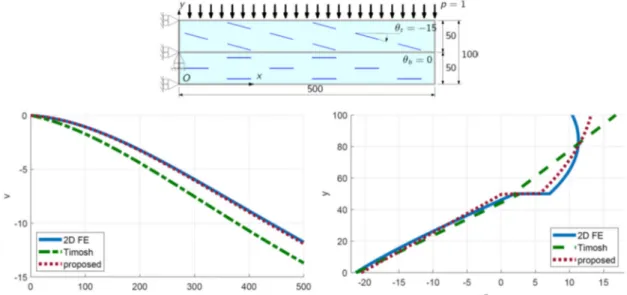ISBN: 978-91-88898-64-7
75
Timoshenko beam with enhanced stress recovery and constitutive relations describing
the effects of variable grain direction on the behavior of a GLT beam
Giuseppe Balduzzi†*, Simone Morganti‡, Josef Füssl†, Mehdi Aminbaghai†, Alessandro Reali‡, and Ferdinando Auricchio‡
†Vienna University of Technology, Austria, Giuseppe.Balduzzi@tuwien.ac.at, Josef.Fuessl@tuwien.ac.at,
Mehdi.Aminbaghai@tuwien.ac.at
‡University of Pavia, Italy, simone.morganti@unipv.it, alessandro.reali@unipv.it, ferdinando.auricchio@unipv.it
Laser scanning technologies allow to collect detailed information on wood grain orientation on the surface of boards by means of the so called tracheid effect [1]. Obviously, such information could be exploited for accurate analysis of Glued Laminated Timber (GLT) beams [1,2], but it unavoidably requires models that properly account for the influence of grain direction on the strength and the stiffness of the assembled GLT beams. In greater detail, when the principal directions of an anisotropic material have arbitrary orientation, material constitutive relations are represented by a full matrix. Despite this peculiarity of anisotropic material could seem trivial, it deeply influences both stress distribution and beam stiffness, and it has been only partially addressed in literature.
This contribution aims at discussing (i) an iterative procedure for the recovery of the cross-section stress distribution, capable to effectively describe the effects of grain direction and (ii) a strategy for the evaluation of the beam constitutive relations to be used in a Timosehnko beam model. Specifically, the stress-recovery exploits the first material constitutive relation, the 2D horizontal equilibrium, and the beam equilibrium Ordinary Differential Equation (ODEs). The resulting distribution of axial stress depends not only on both axial deformation ε(x) and beam curvature χ(x) via the Young’s modulus, but also on the transversal internal force V(x) via the non-vanishing out-of-diagonal terms of the matrix representing the material constitutive relation. The derivation of the beams constitutive relations exploits the stress recovery outputs and guarantee energy consistency between a simplified 1D model and the 2D elastic problem, leading every beam deformation to depend on all internal forces. The analytical solution of Timoshenko beam ODEs highlights that a coupling term relating the transversal internal force V(x) with the curvature χ(x) can influence the transversal displacement of the structural element stronger than shear deformation.
A systematic comparison with 2D finite element solutions, obtained using very fine meshes, demonstrates the effectiveness of the proposed modelling approach. Specifically, the proposed beam model and the standard Timoshenko one, classically adopted in engineering practice, have similar costs. Nevertheless, the proposed model estimates maximal displacements and stresses with relative errors usually smaller than 10%, describing phenomena that occur in multilayer anisotropic beams with an accuracy reasonable and sufficient for most engineering applications. Conversely, coarse adaptations of beam models developed for isotropic structural elements may lead to errors greater than 30%, resulting inadequate also for basic engineering applications (see Figure 1).
Figure 1: Bi-layer cantilever with distributed load, E11=104MPa, E22= E11/20, G= E11/10, υ=0. Comparison of transversal displacements and axial stress evaluated at x=250mm, 2D Finite Element, Timoshenko beam, and proposed beam model solutions
References
[1] Kandler, G., J. Füssl, E. Serrano, and J. Eberhardsteiner: Effective stiffness prediction of GLT beams based on stiffness distributions of individual lamellas. Wood Science and Technology 49, (2015), 1101-1121.
[2] Balduzzi, G., G. Kandler, and J. Füssl: Estimation of GLT beam stiffness based on homogenised board mechanical propertie and composite beam theory. Proceedings of the 6th European Conference on Computational Mechanics (2018), 1280-1291.
